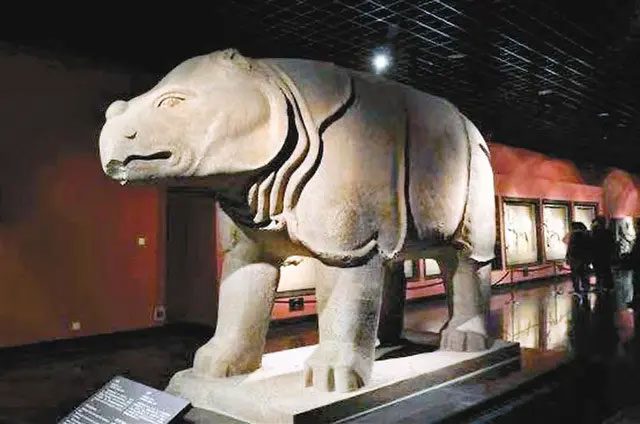Many Chinese people are unaware that the national treasure weighing 10 tons currently displayed in their country originates from Vietnam.
National Treasure of China
“To find cultural relics on the ground, come to Shanxi; to seek artifacts underground, head to Shaanxi.” For the Chinese, it is not an exaggeration to say that if one were to dig a hole anywhere in Xi’an, the capital of Shaanxi province and the ancient capital of thirteen Chinese dynasties, they could uncover several valuable Han dynasty bricks or Qin dynasty tiles. The Forest of Stone Tablets at the foot of the ancient city wall in Xi’an is indeed a treasure trove of such artifacts!
At the Xi’an Forest of Stone Tablets Museum, there is a room dedicated to stone sculpture art that currently houses a 10-ton stone rhinoceros sculpture, which has been listed as a national treasure of China.
According to the Xi’an Evening News (managed by the Xi’an Municipal Committee), the sculpture is known as the Xianling Stone Rhinoceros, designed from green stone sourced from the Fuping region in Shaanxi province. It measures 340 cm in length and 209 cm in height, boasting a robust and imposing form, with clear lines and proportional dimensions. Viewed from a distance, the sculpture appears even more vibrant and powerful, making it an ideal piece to be placed in front of a tomb in a desolate area.
Xianling is the tomb of Li Yuan, the founding emperor of the Tang dynasty, located in the San Yuan County of Shaanxi province. Among the stone sculptures placed before the tomb, there is a pair of stone rhinoceroses. In 1959, one of them was transferred to the Shaanxi Provincial Museum, now known as the Stone Sculpture Art Exhibition Hall of the Xi’an Forest of Stone Tablets Museum.

Xianling Stone Rhinoceros. (Photo: Xi’an Evening News).
The stone rhinoceros has its mouth closed, with a horn protruding from its snout like a fleshy bump. Its feet have three toes, and it is depicted in a walking stance. The sculpting technique of the statue does not pursue excessive intricacy but captures the characteristics of the rhinoceros, such as the thick, sagging skin under the neck and its heavy body and demeanor.
“The stone rhinoceros sculpture is not only the only artistic masterpiece featuring a rhinoceros placed before the 18 Tang dynasty tombs but is also a rare example in national tomb sculpture art,” reported a Chinese newspaper.
On the pedestal under the front right hoof of the Xianling stone rhinoceros, there are six carved characters: “Gaozu Huaiyuan Zhi De”, which means praising the merits of Emperor Gaozu of Tang, Li Yuan.
The custom of using rhinoceroses to symbolize authority dates back to the Western Han dynasty. During the reign of Emperor Ping of Han, when Wang Mang was in power, he persuaded the king of the Huang Chi state, now part of Kancheepuram (India), to tribute a live rhinoceros to the Western Han dynasty. It can be seen that by the end of the Western Han dynasty, rhinoceroses had at least disappeared from Guanzhong (northern China). Otherwise, Wang Mang’s appeal to the king of Huang Chi for a rhinoceros would undermine the practical significance of showcasing the Han royal family’s virtues, not to mention the purpose of self-promotion.
The stone rhinoceros in the tomb of the Chinese emperor also embodies this significance. According to the Xi’an Evening News, the fleshy bump on the snout of the Xianling stone rhinoceros indicates that it is a species of rhinoceros, now extinct, that originated from Southeast Asia, specifically from Vietnam.
Originating from Vietnam
In the work New Book of Tang (China), it is recorded that in the early years of the Zhenguan era, the state of Linyi (now in central Vietnam) sent live rhinoceroses as tributes to the Tang dynasty, and Emperor Gaozu of Tang, Li Yuan, was very fond of this tribute. By the ninth year of the Zhenguan era, after Li Yuan’s death, Emperor Taizong of Tang, Li Shimin, ordered craftsmen to carve a pair of stone rhinoceroses based on the appearance of the rhinoceros presented by Linyi, placing them before the Xianling tomb as a sign of filial piety.
Throughout the Tang dynasty, there were very few opportunities to see live rhinoceroses in the plains, with one or two occasionally appearing in the capital as tributes from foreign lands. Therefore, rhinoceros-themed handicrafts during the Tang dynasty were not very lively.
Only the stone rhinoceroses at Xianling were carved with great realism, indicating that when the craftsmen sculpted the stone rhinoceroses before Emperor Gaozu’s tomb, they must have seen these animals with their own eyes.
The Chinese newspaper concludes that the Xianling stone rhinoceros not only represents the valiant virtues of the Tang emperor during his lifetime but has also become an artifact reflecting the cultural exchange between China and foreign countries in ancient times. From the seemingly sluggish appearance of the rhinoceros, viewers can sense its fierce, mighty, massive, and vigorous spirit within. Despite depicting an animalistic nature, it does not instill fear; rather, it draws admiration. It is a rare and valuable piece of art.





















































